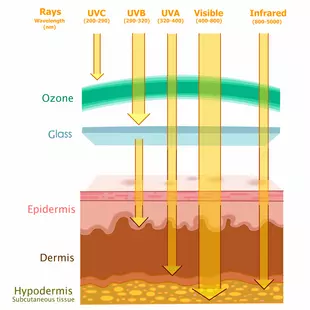UV erythema in the workplace
UV erythema, also known as sunburn, is a dermatologic condition that can occur outdoors, at home or in the workplace. UV erythema is a reddening of the skin caused by exposure to UV radiation. This reaction is similar to sunburn and is an indicator of skin damage caused by UV radiation. Workplace UV erythema refers to a reddening of the skin caused by exposure to ultraviolet (UV) radiation. This type of UV erythema is common in people who work outdoors, such as on construction sites, in agriculture or during outdoor sports activities.
However, people who are exposed to UV radiation at work can also develop UV erythema. This page deals with the causes, consequences and protective measures against UV erythema in the workplace, as well as the recommended treatment strategies.
Consequences of UV erythema in the workplace
The mild effects of UV erythema can include slight redness, itching and pain.
These symptoms are usually short-lived and normally subside within one to two days, but can last up to five days. For the eyes, UVC can cause photokeratitis and photoconjunctivitis, both conditions which, although unpleasant, are usually reversible and preventable by wearing appropriate protective eyewear.
Although these symptoms are usually temporary, a recurrence of UV erythema is a warning sign of potential damage to the skin, including an increased risk of skin cancer. It is therefore important to take the symptoms seriously and take preventative measures.
Although UV erythema in the workplace often appears as a mild skin irritation, in some cases, especially with long-term exposure, it can have more serious consequences. These include:
- premature skin aging
- pigmentation disorders
- an increased risk of skin cancer
Treatment of UV erythema
The treatment of UV erythema usually includes
- Cooling: the application of cold compresses can help to reduce inflammation and redness.
- Moisturizers and aloe vera: These can help soothe the skin and speed up the healing process.
- Avoid further exposure: It is crucial to minimize further exposure to UV rays until the erythema has healed.
- Pain relief: If the pain is severe, over-the-counter painkillers such as ibuprofen or paracetamol can help to relieve the discomfort.
- Consultation with a dermatologist: If symptoms persist or UV erythema occurs frequently, a specialist assessment and consultation is recommended.
In case of eye damage, it is recommended to wear UV protective eyewear as a preventive measure and in case of photokeratitis to avoid further exposure to light and to use artificial tears to alleviate symptoms.
Protective measures and personal protective equipment (PPE)
Various protective measures are required to prevent UV erythema in the workplace, including The first priority is to determine the exposure. The spectrum, irradiance and duration of exposure are important.
According to § 7 OStrV, the following order of priority must be taken into account when determining and implementing protective measures:
- avoidance or minimization of hazards from incoherent optical radiation
- technical protective measures
- organizational protective measures
- personal measures, in particular personal protective equipment
- Employers should provide appropriate personal protective equipment (PPE), such as protective goggles, gloves, long-sleeved clothing, but also sun creams with a high sun protection factor (SPF)
- Education and training: training on the risks of UV exposure and the proper use of PPE can help raise employee awareness of the importance of UV
- protection measurements and risk assessments
- measurement data is used to assess worker exposure on the basis of the "Artificial Optical Radiation Directive" and to determine the permissible daily exposure Heff and HUVA according to guideline 2006/25/EC. These limit values are defined specifically for UV radiation with wavelengths between 180 and 400 nm. They represent conditions under which most healthy workers can be repeatedly exposed without suffering acute health damage such as erythema (reddening of the skin) or photokeratitis (a type of eye damage). These limits apply particularly to continuous radiation sources and are designed to provide a guideline that makes the use of UV sources safer, but should not be seen as a strict dividing line between safe and unsafe.
Summary for the prevention and treatment of UV erythema in the workplace
In summary, effective management of UV erythema in the workplace involves not only the treatment of symptoms following exposure, but more importantly, preventative measures to minimize the risk of future events. By adhering to protective measures, employers and employees can significantly reduce the risk of UV erythema and the associated long-term skin damage.




